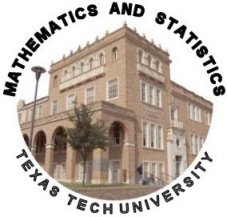Workshops for Students
What is infinity? How far is it to infinity?, Room MATH 112.
Dr. Roger W. Barnard
Abstract: We will discuss Zeno's Paradox and the stereographic projection to
determine if infinity isunattainable or can one get there.
Fun with Difference Equations, Room MATH 114.
Dr. Raegan Higgins
Abstract: This will be a brief and down-to-earth introduction to difference
equations. We will introduce a variety of basic sequences. We will see how to
establish recursive relationships and in some instances, see how to use these
recursive relationships to establish explicit formulas.
How math can help you survive a zombie apocalypse and win the lottery, Room MATH 110.
Mr. Levi Johnson, Mr. John Calhoun
Abstract: The talk will be an interactive examination of how simple probability
can help us understand the world around us. We will specifically examine games
of chance and zombie outbreaks. We will also discuss college and career
opportunities for students who are interested in learning more.
Greeks, Graphs, Bridges, and Brains, Room Math 109.
Dr. Brock Williams
Abstract: Dice games usually use 3-dimensional, 6-sided cubes as dice. Cubes are
completely regular - all the sides and angles are the same - so they make great
dice. But it is also possible to make dice with 4, 8, 12, or 20 sides using the
other Platonic solids. The ancient Greeks discovered, however, that those are
the only regular dice you can make! We'll discuss why that's true and how it
applies to current research on visualization of very irregular surfaces such as
brains.
Mathematics, Quilting, and Design, Room MATH 108.
Mrs. Carol Williams
Abstract: There is a tremendous amount of mathematics in the creation and design
of quilts, clothes, and other textiles. We will design our own quilt blocks and
discuss along the way the connections to fractions, scaling, symmetry, and
economics.
What can a mathematician do?, Room MATH 111.
Dr. Clyde Martin
Abstract: In this talk I will discuss some of the many things that you can do with
mathematics from teaching to research. Most people think that about all you can
do with mathematics is teaching but that is not the whole truth. Some of the
questions that mathematicians ask are things like: Why are diabetes and obesity
related? How do stress fractures develop in the leg bones? Can stress fractures
be eliminated? What will happen if many children don't receive their
vaccinations? These are questions that I have and am studying and we will talk
about some other questions time permitting.
Dynamics of Predator-Prey and Competition Interactions,Room MATH 113, COMPUTER LAB.
Dr. Sophia Jang
Abstract: Mathematical models are important tools to study biological phenomena.
We shall introduce several classical models from ecology and use computer
simulations to study population interactions. We will explore the cyclic behavior
of the predator-prey interactions and of the competition outcomes for two
competing populations. We will see when the predator and prey populations can
coexist and when the predator will drive the prey population to extinction in a
predator-prey system. We will also examine which population can out-compete the
other population, when two populations utilize the same limited resources.
|

